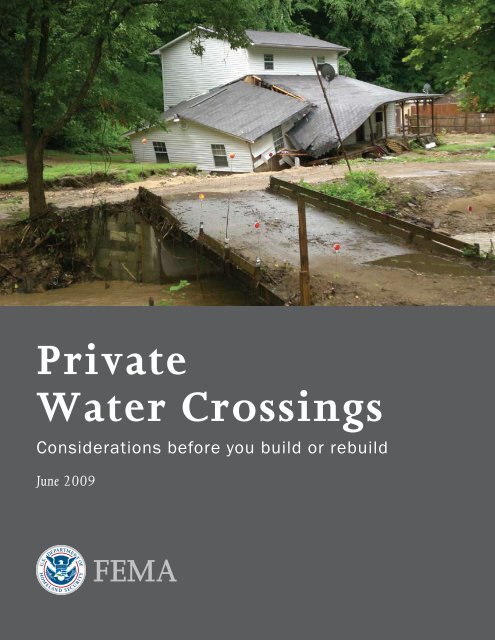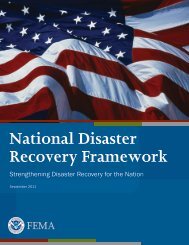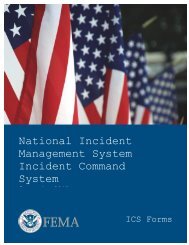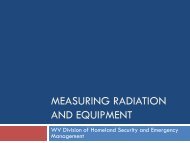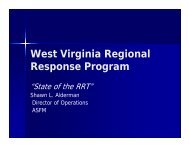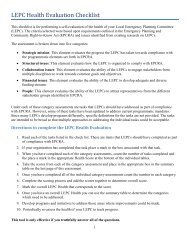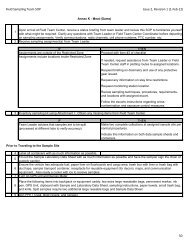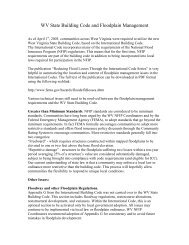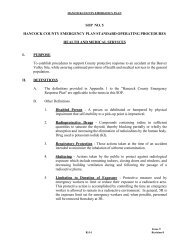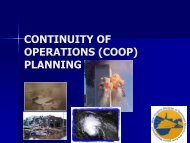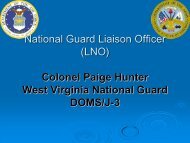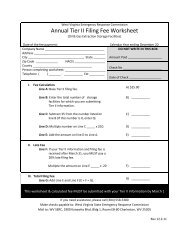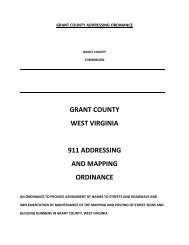Private Water Crossings: Considerations Before You Build
Private Water Crossings: Considerations Before You Build
Private Water Crossings: Considerations Before You Build
- No tags were found...
You also want an ePaper? Increase the reach of your titles
YUMPU automatically turns print PDFs into web optimized ePapers that Google loves.
PRIVATE WATER CROSSINGSTable Of Contents1. Introduction 12. Obtaining a Permit 23. <strong>Water</strong> <strong>Crossings</strong> 33.1 Bridges. . . . . . . . . . . . . . . . . . 43.2 Culverts . . . . . . . . . . . . . . . . . . 93.3 Low <strong>Water</strong> <strong>Crossings</strong> . . . . . . . . . . . . . 134. Definitions 15
PRIVATE WATER CROSSINGS | 11.IntroductionThis booklet addresses the necessity for carefulconsideration of a number of issues to gain orregain, and to maintain safe ingress and egress overwater bodies utilizing private crossings.It is imperative that all watercourse crossings,including bridges, low water crossings andculverts be properly designed and constructedto perform safely and adequately under varyingnatural conditions. Any watercourse crossinghas the potential to alter or disrupt the waterwaycharacteristics from the low to high flowconditions. Improper installations can result inextensive loss and damage to public and privateproperty, danger to human life, as well as damageto the environment as a result of flooding, erosionand washouts. Maintaining the overall integrity ofthe waterway is of the utmost importance.Construction should be performed during dryweather and not prolonged. This will minimizerisks to both the project and the environment.Installation should not be done in frozen ground.Structural design should be based on maximumanticipated water depth and velocity in additionto the intended use of the crossing. Longer andhigher bridges are often more economical becausethey will sustain less damage in future flood events.The actual design and installation of the crossingneeds to be coordinated with all persons whomay be involved in the project: owner, engineer,contractor and governing agencies (local, state andfederal).Because each land and water site is unique, and thetype of materials and the quality of constructionvary, mechanisms must be customized to eachlocation. It is not possible or desirable to attempt toaddress all considerations. The Federal EmergencyManagement Agency (FEMA) therefore doesnot warrant the completeness, inclusiveness orcomprehensiveness of the discussion that follows.In selecting or evaluating a crossing site, some characteristics should be considered.The chosen location should be economical to both construct and maintain.<strong>Water</strong>way crossing sites should be selected using the following criteria:• Fairly level and sufficiently long approaches with gentle slopes.• Firm and stable soil conditions.• Relatively shallow water depth and low velocity during floods.• Away from fish spawning areas, water intakes and lake outlet sites.• Minimum probability of scouring and sediment displacement.• Adequate space for entering the public highway at right angles.
(01/23/2008) page 1 of 82 | PRIVATE WATER CROSSINGS2.Obtaining a PermitAll construction of waterway crossings requirepermits from at least one if not multiple local, stateand federal agencies before any work can begin.Permits may also be required for any or all ofthe following: Alterations, enlargements, repairs,maintenance and removal of bridges, culverts orlow water crossings. No matter where you live,there exists some form of permitting processrequired for any watercourse encroachment oralteration. Very often a local soil conservationdistrict agency works along with the UnitedStates Army Corps of Engineers, Federal and StateClean <strong>Water</strong> Act representatives, Department ofNatural Resources, Environmental ProtectionAgency, United States Fish and Wildlife Service,State Division of Highways and a local FloodplainAdministrator.Documentation or verification should be givento the Floodplain Manager establishing that theflood carrying capacity within the altered areaof the stream in question will be maintained. Ifhydrologic and hydraulic analyses are required,qualified personnel shall perform them.<strong>Build</strong>ing techniques that may be required to presenta “best practice” in the construction of a bridge,culvert or low water crossing may include: WingDepartment of Natural Resourceswalls, trash grates and the sizing of openings tocarry anticipated future increases in flood heights.The design or redesign and the actual constructionof a waterway crossing are separate parts of thetotal project often handled by different persons. Ifso, it is important that installation procedures areconsidered during the design phase of the crossing.Communication and coordination betweendesigner, builder and regulating agencies isnecessary to achieve a quality-finished product witha minimum of environmental alterations or damageto the site. A minimal amount of time should bespent in the actual water channel.The builder usually is responsible for obtainingthe necessary permits and ensuring the day-to-dayconstruction practices follow all local, state andfederal regulations, specifications and guidelines.Each waterway crossing is unique and requireswell-planned construction methods.Failure to follow the local permitting process andobtaining approval from all authorities havingjurisdiction can result in a delay of your installationor an order to stop construction and formalenforcement actions, including financial penalties.General PermitClear Span BridgeGeneral Permit PacketA General Permit is available for a clear span bridge under NR 320, Adm. Code. To qualify for this general permit, your projectmust meet eligibility standards. Designing your project to meet these standards helps conserve fish and wildlife habitat, waterquality and other public rights which we all enjoy. In addition, this will help us make a prompt decision on your proposal.This application packet will allow you to supply the needed information for us to assure your project is eligible for a generalpermit. <strong>You</strong> will want to begin by gathering all the information contained in the checklist below. If your project is eligible, ormeets all the criteria below, you should then fill out the general permit application and furnish that to the identified office forreview.if you do not supply all the information contained in the eligibility requirements checklist or on the application, yourproject cannot be reviewed. after we receive your complete package, we will respond within 30 days to notify you thatyour project is eligible or that additional information is required to complete your application. In some cases, you may benotified that your project requires an individual permit.WHat YOU neeD tO inClUDe WitH YOUr aPPliCatiOn:note: To avoid delays, supply all of the information listed below in a complete and organizedformat. Detailed descriptions of the necessary information and common mistakes can be foundin our Permit Partner Document.qPhotographs showing the entire project site inwaterbody in pre-construction
4 | PRIVATE WATER CROSSINGS3.1 BridgesQuality designed and constructed bridges canmaintain the original watercourse channel bedwithout any alteration or disturbance. Sometypes of structures tend to restrict and obstruct thenormal and above normal flow of the waterway.Clear-span bridges do not require infilling orrestrict the area of water flow as culverts or multispanbridges do.Bridges provide better capacity to accommodatehigh flows while creating better inlet and outletconditions that allow debris to pass throughwithout blockage.Flood damage to bridges includes floodwatersoverwhelming the deck and superstructure as aresult of inadequate attention paid to the hydrauliccapacity of the bridge. Damage also results fromimpact and accumulation of debris.WATERFLOWBANK STABILIZATION AT ALL FOURBRIDGE QUADRANTS SEED ANDMULCH OR SODWINGWALLGUARDRAILBRIDGEDRIVEWAY OR LANERIPRAP INSTALLEDUNDER BRIDGE ANDALONG BANKS TOSTABILIZE AREA IF THEESTABLISHMENT OFVEGETATION OR FILTERFABRIC IS NOTAPPLICABLE.SALVAGE ANYTREES ANDSHRUBSWATER CHANNELSHOULD BE LEFTUNDISTURBEDFigure 3.1-1. Plan view of bridge
PRIVATE WATER CROSSINGS | 5Design consideration for bridges:• Span the entire water channel without altering the water banks or bed and having the abutmentsor piers encroaching into the channel.• Adequately handle storm water runoff from the roadway.• Utilize a “perched” bridge design with low roadway approaches to sacrifice the roadway and savethe bridge under severe flood conditions.• Install wing walls to direct the water flow into the bridge opening to eliminate potential erosion.• Avoid the direct contact of uncured concrete and pentachlorophenol - treated wood with thewater to avoid the toxic reaction to aquatic life.• Handrails or guardrails should be installed where necessary.• Stabilize the disturbed areas with native vegetation whenever possible versus using structuralsolutions: bulkheads, riprap and other structural solutions.Figure 3.1-2. Concrete is beingpoured into a wood form for acast in place reinforced concretebridge abutment with wing walls.This abutment design was dictatedby a short approach, but it isstill high and set back far enoughfrom the water channel to allowunobstructed water flow and safepassage to and from the property.Figure 3.1-3. Bridge with wingwalls direct water flow during highwater to avoid washout of bridgeapproach and increase of waterflow velocity. Guardrails on bridgesafeguard traffic passage.
6 | PRIVATE WATER CROSSINGSFigure 3.1-4. This bridge designwas dictated by exposed bedrock.Site-specific conditions and goodjudgement resulted in safe trafficpassage and a practical approachto stream protection. Even duringhigh water, this bridge shouldmaintain appropriate flow andstreambed and not constrict thestream.Figure 3.1-5. <strong>Private</strong> bridgewith secured handrails andunobstructed water flow allowsfor safe traffic passage and createsno noticeable change in thestream flow or streambed. Thebridge crossing is wide and highrelative to its length.Figure 3.1-6. Perched bridgeand low water crossing. The lowwater crossing is used only forinfrequent passage by heavy farmequipment. The perched bridge isfor regular access to property, butcan become an island during aflood if the road on both sides isunder water.
PRIVATE WATER CROSSINGS | 7Figure 3.1-7. A bridge pierlocated in the water channel createsscouring and debris catch whichexacerbates the impact of flooding.Routine maintenance is required toprevent accumulation of debris.Bridge Crossing ProblemsFigure 3.1-8. Bridge abutmentsencroaching into the stream createsa weakening of the structuralintegrity of the crossing duringhigh water flow by erosion andscouring.Figure 3.1-9. The lack of wingwalls and a short bridge spancauses loss of bridge approachduring high water. A longer bridgespan with abutments set back fromthe water channel utilizing wingwalls would avoid scouring anderosion.
8 | PRIVATE WATER CROSSINGSThe bridge design below has been successfully usedwhere the stream banks are firm enough to preventerosion and support the abutments. No concreteis needed. The stringers are welded to the steelabutment members that sit directly on the soil.Appropriately designed bridge foundation can alsobe gabion abutment, footings or logs set into rockor firm stable soil.STEEL ANGLETO SUPPORTDECK LUMBERBACKFILLWITH STONETIMBERDECKGALVANIZEDSTEEL PLATEFigure 3.1-10. Side elevation section view of private bridge without concrete abutmentsThe deck slab or stringers should be set above theexpected high water level to allow for debris andstorm flow passage. Add protection against sour,such as riprap, gabions or vegetation.BACKFILL WITHSTONEANGLEIRONTIMBERCURBSTEELABUTMENTMEMBERSTEELSTRINGERSTIMBERDECKGALVANIZED STEEL PLATE(WELD OVER “I” BEAMSTRINGERSAND ABUTMENT MEMBERFigure 3.1-11. Perspective and section view of private bridge without concrete abutments
10 | PRIVATE WATER CROSSINGSFigure 3.2-2. This multipleculvert crossing is vulnerable todebris blockage and washout.To install multiple or a “gang”of culverts properly, each culvertmust be spaced adequately toallow for proper soil compactionbetween the culverts. This fillmust be well armored at eachend to prevent the washing outbetween the culverts.Figure 3.2-3. (right) Insufficient cover for culverts willresult in washout and erosion as well as structural failure andcollapse of culverts.Design considerations for culverts:• The culvert must provide for proper road width and side slopes.• Wing walls may be used to aid in directing the flow of water at the outlet and directly into theinlet to help prevent erosion.• Headwalls may prevent washouts at steep slopes and unstable fill sites.• Culvert should be installed so that the existing waterway slope/gradient is not changed.• The culvert should be aligned with the waterway, with no changes in water flow direction at theupstream or downstream area of the crossing.• Culverts should never be installed with bends in them.• Recess the bottom of the culvert to a depth at least 12 inches below the existing streambed or tothe projected scour depth of the natural channel.• When a debris barrier/trash grate is used to catch debris, the grate should be installed with alow incline to prevent floating debris from being held against the grate by the flow. This cancause washouts.• Culverts should be inspected after heavy rainstorms and flood events.• Height restrictions may require the use of a horizontally elongated culvert, which result inbetter low flow characteristics.
PRIVATE WATER CROSSINGS | 11• Cast-in-place or self-setting concrete bag headwallsexposed to the watercourse are less desirable than precastconcrete or sandbagged headwalls, due to the releaseof leachate and resulting fish kill.• Sandbagged headwalls are traditionally used as a temporarymeasure and for sandy non-clay soil conditions.• Adequately designed and constructed bottomless arch culvertscan maintain natural streambed and match the upstream anddownstream water depth and velocity.Figure 3.2-4. Culvert withsandbagged headwall is beingused in a sandy soil drainageditch. This method should notbe used for permanent use inwater courses.Figure 3.2-5. Multipleculverts at driveway ditchcrossing have adequate spacingand compaction. The concreteheadwall and wing walls helpdirect water flow and preventwashouts during high waterflow. There is also adequatecover and culvert length toallow liberal clearance oftraffic.
12 | PRIVATE WATER CROSSINGSFigure 3.2-6. This headwall at aculvert inlet protects against erosionand washout. Many inlet failuresoccur on culverts without headwallsor other entrance protection. Whensoils adjacent to the inlet are erodedor become saturated, pipe inletscan be subjected to buoyant forcescausing culverts to dislodge andwashout.Figure 3.2-7. Culvert alignedwith stream and armored withstone at inlet and outlet. Naturalstreambed conditions preservedby embedding culvert, allowingwater to flow naturally withoutundercutting the inlet and causingerosion.Figure 3.2-8. These culvert wingwalls aid in directing water flow.The mitered or skewed ends ofcorrugated metal pipes, cut toconform to the embankment slopes,offer little resistance to bending orbuckling without wing walls. Wingwalls help prevent scouring andprotect embankment slopes.
PRIVATE WATER CROSSINGS | 133.3Low <strong>Water</strong> <strong>Crossings</strong>Low water crossings have limited application dueto continued disturbance of the streambed andfrequent inundation. Do not use a low watercrossing to serve occupied dwellings where noalternate emergency access is available. They aremore suitable for low volume roads with nohabitable dwellings where the normal volume ofwater flow is relatively low.Low water crossings can be useful for infrequentlycrossed waterways that experienceflash floods, since it would beIMPASSABLEuneconomical to construct a bridgeDURINGor culvert. Debris problems andHIGH WATERother maintenance are minimized.Proper signs should be usedwarning of the dangers of high water.Figure 3.3-2. Concrete vented ford - this type of crossing has alow cost and low maintenance. Fish passage and scouring problemsare a disadvantage as well as a danger to traffic during high flowperiods.The more stable the streambed and banks are withbedrock, and the lower the existing bank slopes andgrades are, the more suitable the site is for a lowwater crossing. Approach grades should be less than10%. Sites that consist mostly of sand and/or siltare not appropriate for fording/crossing.Two types of low water crossings are the unventedford and the vented ford.Unvented fords are constructed of riprap, gabions,or concrete to provide a stream crossing withoutthe use of pipes where streams are dry most of theyear and crossing use is temporary. <strong>Water</strong> depthflow over an unvented ford should not exceed 6inches.Figure 3.3-1. Low water crossing - this can be suitable for verylow-volume access. Unimproved ford is a natural crossing that isundesirable for daily use.Vented fords use pipes under the crossing to allowlow flows to pass through without regularly passingover the crossing. The pipes or small culverts maybe placed in aggregate, riprap, gabions or concrete.
14 | PRIVATE WATER CROSSINGSA box culvert is a crossing design that is usedmore frequently in areas where habitat protectionis important. A single or series of box culverts areembedded with continuous streambed materialthrough the structure. These structures perform likea bridge by matching the channel width.It is important that any washout of streambedmaterial during high water flow is refilled naturallywith sediment as flow recedes.ROAD SURFACEBANKFULL WIDTHNATURAL CHANNELPROFILEANTI-SCOURDOWNSTREAMCUTOFF WALL(TYPICALLY 3’ - 5’DEEP)Figure 3.3-3. Embedded box culvertsEmbedded box culverts maintain a continuousstreambed through the structure. If site conditionspermit, an open-bottom box with a natural streamEMBEDDED BOXCULVERTS SETBELOW CHANNELLEVEL 12”-24” TOFORM A “NATURAL”STREAM BOTTOMchannel bottom is preferable in sustaining channelfunction.Figure 3.3-4. Concrete vented ford - The number of box openings depends upon the width and flow of the channel. A continuousstreambed maintains channel function.
PRIVATE WATER CROSSINGS | 154. DefinitionsAbutment: Part of a structure which supportsthe end of a span; often supports and retains theapproach embankment.Aquatic Life: All forms of living things found inwater, ranging from bacteria to fish and rootedplants. Insect larva and zooplankton are alsoincluded.Armoring: A facing layer (protective cover),or riprap, consisting of very large stones placedto prevent erosion or the sloughing off of anembankment.Best Practice: The optimum construction methodput into practice at a particular place and time.Bridge: A watercourse crossing that can maintainthe original natural watercourse channel bedwithout any alteration or disturbance. This crossingstructure is built so that people can get from oneside to the other.Cast-in-place concrete: Concrete in anunhardened state, primarily as ready-mix andpoured in forms to harden on-site.Clear-span: Bridge structures that completely spana watercourse and do not encroach on the naturalchannel width by the placement of abutments,footings or armoring so that there is no restrictionto the natural channel processes.Conduit: Any pipe, tube, or drain tile throughwhich water is conveyed.Conveyance: Floodwater carrying capacity in apassage area of a watercourse.Culvert: A drain, pipe or channel which allowswater to pass under a road or embankment.Debris: Any material including floating woodymaterials and other trash, suspended sediment orbed load moved by a flowing stream.Deck: The top surface of a bridge which carries thetraffic.Embankment: Angled grading of the ground.Filter fabric: Geotextile erosion fabric used tocover and stabilize topsoil for use with riprap andground cover.Floodwaters: <strong>Water</strong> flows that have risen above thestream bank and flow over adjoining lands.Gabion: A galvanized wire box filled with stones/riprap used to form an abutment or retaining wall.Headwall: A wall at the end of a drainage structuredesigned to prevent erosion of the embankment atits entrance or outlet.Infilling: Soil, rock, gravel or a combination placedin a depression or ditch to fill the void. Used inconjunction with a culvert.Low water crossing: A fording site of a waterway.Multi-span bridge: Multiple horizontal spacesbetween two abutment supports, with one or morepiers at a location between abutments.Perched bridge: Style of bridge elevated or raisedat both ends to avoid floodwaters and create lowroadway approaches. The bridge is higher than thefloodplain, but the approaches are much lower.Pier: A vertical structure (column or pile), whichsupports the ends of a multi-span superstructure ata location between abutments.
16 | PRIVATE WATER CROSSINGSPiping: Washing out or erosion between andaround culverts.Pre-cast concrete: Concrete components which arecast and partly matured in a factory or on the sitebefore being lifted into their final position as partof a structure.Riprap: Rock placed on embankment slopes toprevent erosion.Sediment: Stone, gravel or cobbles that originatefrom the weathering of rocks and is transported by,suspended in, or deposited by water.Scour: The result of an erosive action of flowingwater in waterways, excavating and carrying awaymaterial from the bed and banks.Span: The horizontal space between two supportsof a structure. Also refers to the structure itself.Trash Grate: A debris guard or screen placed at theupstream entrance of a culvert, which stops heavyfloating debris away from the culvert entranceduring high velocity flow.<strong>Water</strong>course: Any natural or artificial channelthrough which water flows; a lake, river, creek,stream, wash, arroyo, channel or other topographicfeature on or over which waters flow at leastperiodically.Wing wall: Side extensions of a retaining wall aspart of an abutment; used to contain the fill of anapproach embankment and to direct and confinethe flow.


